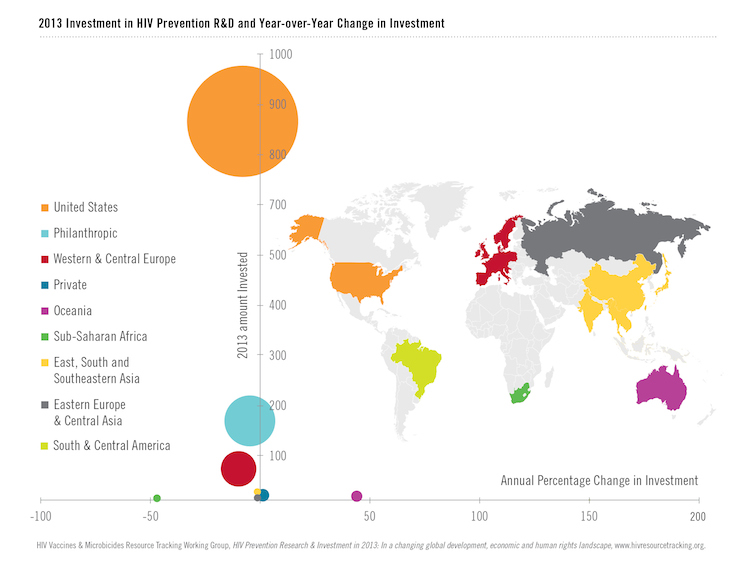Contacts:
AVAC: Mitchell Warren (in Melbourne) [email protected],
+1‐914‐661‐1536; Kay Marshall, [email protected], +1-347-249-6375
IAVI: Arne Naeveke (in Melbourne), [email protected], +1.646.623.4785; Barbara Rosen, [email protected], +1-212-847-1056
UNAIDS: Sophie Barton‐Knott, [email protected], +41 79 514 6894
Report shows prevention R&D funding falls 4% due to public sector research budget reductions in US, Europe
Melbourne, Australia, 18 July 2014 – Investment in HIV prevention research fell 4 percent in 2013, due to a combination of factors including declining investments by the United States and European donors, changes in the international development landscape and changes in the pipeline of HIV prevention products being tested, according to a new report from the HIV Vaccines and Microbicides Resource Tracking Working Group. In 2013, total investment in prevention research was US $1.26 billion, down US$50 million from 2012.
HIV Prevention Research & Development Investment in 2013: In a changing global development, economic, and human rights landscape is the tenth annual report by the Working Group, a collaboration between AVAC, UNAIDS, and IAVI. The report summarizes investment in HIV prevention research across nine prevention options. The report was released today ahead of the 20th International AIDS Conference (AIDS 2014) in Melbourne, Australia. Breakdowns by prevention modality are available in the full report at www.hivresourcetracking.org.
Despite US budget cuts in 2013 and a decline in support for HIV prevention research, the US government remains the single largest funder of prevention research, accounting for more than 70 percent of total investment over the past five years. The US contribution decreased US $44 million to US $881 million in 2013, largely due to automatic, across-the-board cuts to all federally funded programs. Funding from European government donors was also reduced due to shifting paradigms and policies in the international development landscape with reduced support for HIV prevention R&D. Without increased and sustained funding, new prevention options will likely be unable to progress efficiently toward efficacy trials and eventual rollout.
“Research and development has produced a valuable range of medicines, diagnostics and devices to prevent and treat HIV which have to be made more widely available. However, funding is declining at a time when services need to be expanded and better treatments and additional HIV prevention options are needed,” said Luiz Loures, Deputy Executive Director, UNAIDS. “Now is not the time to pull back from science, but rather to push forward towards ending the AIDS epidemic.”
Investment declined in research & development related to voluntary medical adult male circumcision (VMMC) and female condoms, both options that have long been proven effective and are now being scaled-up as part of broader HIV prevention programs. Investment increased for R&D related to treatment as prevention (TasP) and pre-exposure prophylaxis (PrEP), which have more recently proven effective and now require additional implementation science to support wide scale implementation. Declining funding for vaccines and microbicides in 2013, both in various phases of product development, presents a challenge for the revitalization of their respective pipelines in the wake of the completion of several large efficacy trials in the last few years.
“There is a growing consensus that we can end the AIDS epidemic if we develop and deploy the right tools and reach those most at risk,” said Mitchell Warren, AVAC Executive Director. “But we won’t be able to make a sustained impact on the cycle of new infections without development and aggressive rollout of new prevention options – voluntary medical male circumcision, PrEP, treatment as prevention, microbicides and eventually vaccines. We need sustained and flexible funding to ensure that we efficiently develop new options, demonstrate how proven options can be rolled out and deliver what we know works.”
This decline in prevention funding comes during a changing and very challenging human rights environment, as harsh new anti-homosexuality laws and other legislation criminalize those most at risk from HIV/AIDS and make it increasingly difficult to answer critical questions about how the prevention needs of gay men, men who have sex with men, transgender people, sex workers, people who inject drugs and other populations most affected by HIV can be met. This will continue to have an impact on how those trials are funded and where they can be conducted.
“A combination of long-term vision, scientific innovation and generous funding has eradicated smallpox, is close to eradicating polio, and has brought us to an era in which a positive HIV test is no longer an automatic death sentence,” said Margie McGlynn, IAVI President & CEO. “A vaccine will be essential to the global, comprehensive response that can end AIDS once and for all, and sustained and broadened support will be crucial to its development.”
The report and additional infographics on prevention research investment are online at www.hivresourcetracking.org.
###
The HIV Vaccines and Microbicides Resource Tracking Working Group is composed of AVAC, the International AIDS Vaccine Initiative (IAVI) and the Joint United Nations Programme on HIV/AIDS (UNAIDS). The Working Group has been tracking investment in HIV prevention research since 2004.

